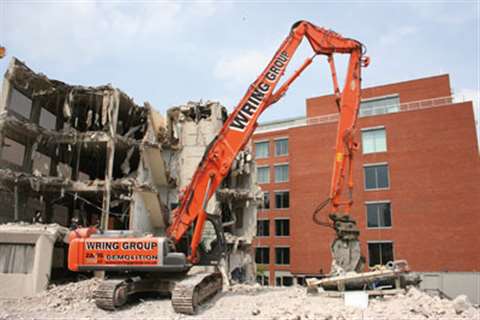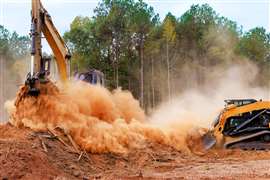Reaching high
12 August 2008

Wring Group Demolition was brought into the Bristol job by project management outfit Gardiner & Theobold, who oversaw the entire project, the demolition phase of which was worth around £700,000 (US$1.4 million).
Built in the late 1960s the building was made up three separate sections, with a centre section of four storeys, an entrance tower of six storeys and a waterside tower of eight storeys. The site provided a few challenges for Wring Group.
Before demolition work could even start, Bristol’s history required that a survey be carried out for to detect any possible unexploded bombs dating back to World War II, when Bristol’s status as a major port meant it was a target for considerable bombing by the German air force.
There were physical challenges as well - on one side of the site, the sides of two of the buildings were right on the river edge, adjacent to a listed wall; the highest tower overhung a dual carriageway, pavement and listed wall; the entrance tower was to all intents overhanging three streets (the dual carriageway, Cheese Lane and Narrow Plain.
Soil investigation began in March 2008, with asbestos abatement talking place at an early stage of two weeks. Wring then proceeded to carry out what it said was a huge strip out task – every floor had suspended floors to accommodate computer cabling and ducting in the voids. More than 40 personnel took three and a half weeks to carry out the soft strip.
The middle of the buildings was stripped out first and the gang was then split in to carry on soft strip at the ends of building. This allowed Wring to begin the demolition section of the structures while sift strip continued. This was necessary since the demolition phase of the redevelopment of the site only ran for 18 weeks, including a reduced dig and placement of a piling mat. In total, soft strip debris amounted to over 500 tonnes, of which Wring estimates it recycled approaching 85%, with the remainder going to landfill. During the demolition phase of the project some 10 Wring personnel were on site.
The three structures consisted of 3 m (9.8 ft) square concrete panels supported by concrete legs and beams. Wring scaffolded across the listed walls to protect them. Where the dual carriageway was concerned, a partial road closure was put in place for a single weekend, with only one lane left active well away from the building. Wring then tracked in a high reach excavator to remove the panels. Once the section immediately adjacent to the road had been brought down, the remainder of that section of building was removed at night.
Wring employed a number of machines n the site, with two Hitachi high reaches forming the backbone (a Zaxis 650 model and a Zaxis 360). In addition, a Hitachi Zaxis 850 demolition spec machine (without high reach, a Hitachi 225, three Hitachi 210s and a 360B Volvo made up the machines that were used on the job.
All concrete and brick debris, totaling between 30,000 and 40,000 tonnes, was crushed on site using an Extec machine. Of this, 20,000 tonnes was used for the piling mate. The rest was transported off-site and sold on.




